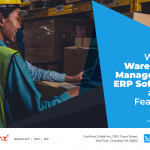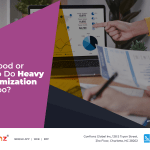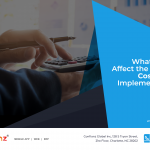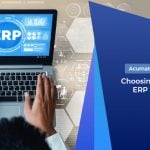By deciding to use an ERP, you’ve made an enormous step for your company’s overall productivity, efficiency, and organization. ERPs can make a big difference to your company’s bottom line.
Unfortunately, an ERP’s usefulness is roughly proportional to the difficulty of the implementation.
That’s why it’s essential to have a game plan before beginning the process. Whether you’re switching ERPs or using one for the first time, these three steps will ensure the transition is as painless as possible!
ERP Implementation Overview
There are a lot of small steps involved in implementing ERP software, but these are the three more comprehensive phases of ERP implementation:
Phase 1: Planning
First, the company needs to decide what they want to achieve with their new system. They also need to identify the business processes supported by the new system and any other requirements for its successful implementation.
Phase 2: Implementation
This is when the company starts implementing their new system, which includes installing it on their computers and training employees on how to use it.
Phase 3: Post-implementation
This is when the company starts using its new system in production and monitoring its performance over time, making any necessary adjustments or improvements along the way.
Phase 1: Setting Yourself Up for Success
The first phase is the most important one, as it sets the tone for the rest of the process. Therefore, if this stage is handled correctly, the rest will go more smoothly.
With everything an ERP can do for your business, it can be tempting to play with your shiny new toy immediately. But that would be a huge mistake.
You want to handle potential disruptions that could cost you big on time, money, and customer trust before they happen. So it makes sense to spend the most time here.
Pick your ERP
Choosing the right ERP for your company is the first step toward a successful transition. We have plenty of articles that give a more detailed breakdown of the pros and cons of the different systems. But there are some basic things you need to decide.
What kinds of features do you need for your company? Do you want an ERP that’s more one size fits all, or are you looking for a more bespoke experience? How scalable do you need your ERP to be?
Form your team
To answer these questions, you need to form a team composed of different members from your company. You should have at least one member from each major division.
A diverse team ensures that everyone’s needs are filled since an ERP should help unify your company. You’ll also have someone who knows what they’re doing in each division to help train the rest of the staff.
Optimize
Once you’ve come to a consensus about which ERP you’ll be using, you’ll move into customizing the system for your particular workplace.
Your developers will need to communicate with each division to get a clear understanding of the current workflow.
When possible, you should keep processes similar while improving efficiency. It will be a lot easier for your current employees to adjust to more incremental changes rather than complete overhauls.
While the design team optimizes the software, the different divisions need to create training literature for their respective area. You don’t want your ERP to disrupt your business, and making sure your employees are trained from the get-go will do a lot to that end.
Don’t forget data
Data migration is a long process that will be happening in the background for most of the implementation.
Data extraction is rarely easy. Most systems don’t want to see you go, so they make extracting your data from their system as complicated as possible.
This is especially true if you aren’t transitioning from a different ERP. You’ll need to gather the data from diverse sources, reformat it, and import it to your new system.
Get started early, so you don’t have to sit on your heels while everything else is ready to go.
Phase 2: Go Time
Once you’ve prepared as much as possible (and I cannot stress the importance of this enough), it’s time to deploy your ERP.
There are a couple of ways to go about this. You can move your departments over one by one (slow and steady) or push the big red button and move everyone over at once (going all-in).
Each method has some pros and cons.
Slow and steady
Pros:
- Your support team can give that particular part of the business and software their full attention.
- You’re less likely to experience business-wide disruption.
Cons:
- Slow. Not the best method for those on a timeline.
- It can be challenging to implement just one part of an ERP and a waste of time to integrate it with software you’re phasing out.
Going all in
Pros:
- You can take advantage of all the benefits of your ERP faster.
- You get to work with the ERP as a whole instead of shoehorning it in.
Cons:
- Far more potential for catastrophe! Your development team may have to put fires out in many different places.
- It can be more overwhelming for your staff if they aren’t given enough attention and preparation.
Which is better?
They’re pretty balanced, so it depends on your business. Larger businesses may want to adopt the slower method since there are more moving parts. However, they may have a more extensive support staff, so the risk may balance out.
Smaller businesses can transition all at once with less danger but may struggle to correct the problems. Again, it’s up to your team to decide the wiser option for your business.
Phase 3: Support and maintenance
Now that your ERP is online and you’ve dealt with the most immediate issues, you may want to go on cruise control. But this is a critical phase.
While you’ve been getting feedback from in-house, now your customers are going to be interacting with the system. Companies are expected to provide post-implementation support to their customers.
Support can look like sending out requests for feedback, increasing your customer assistance team, and putting your development team to work squashing bugs.
Also, make sure to keep up with your team. Processes that may have seemed to work well at first may not have worn well. And there are always more opportunities for optimization!
Trust Confianz with ERP impelmentation
Businesses have a million cogs that all work together. By transitioning to using an ERP, you’re upgrading your machinery, but there’s a massive potential for disruption during the process.
But if you’re diligent about following the steps and working with your employees, you can skip to the part where your business is more efficient and organized than ever!
If you want to make the process as seamless as possible, let us help! Our ERP experts can help you every step of the way, from choosing an ERP to post-launch support. Confianz Global® is an open source Software Development company that provides custom Odoo Implementation, integration and customization with 24/7 support.
